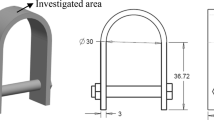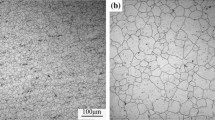Abstract
F321 austenitic stainless steel, well known for its excellent corrosion and oxidation resistance, is widely used as a structural component in the pipelines and pumps of light water reactors (LWRs) and generation IV (GenIV) reactors. However, the material failure arising from the high-temperature softening of the 300 series austenitic stainless steels has recently received significant attention. In this study, we conducted uniaxial tensile tests on F321 stainless steel at different temperatures. Furthermore, we developed a face-centered cubic (FCC) crystal plasticity method emphasizing the temperature factor of the evolution of dislocations inferred by the physical mechanisms at the microscopic level to simulate the polycrystalline mechanical response and model the high-temperature softening phenomenon of F321 austenitic stainless steel. Subsequently, this model was implemented using the ABAQUS finite-element platform. On this basis, the crystal plastic finite-element method (CPFEM) of F321 stainless steel was established. The calculated results were in good agreement with the experimental results, which validated the effectiveness of this numerical method.





Similar content being viewed by others
References
Was GS, Ukai S. Austenitic stainless steels. In: Structural Alloys for Nuclear Energy Applications; 2019; 293–347. https://doi.org/10.1016/B978-0-12-397046-6.00008-3
Byun TS, Hashimoto N, Farrell K. Temperature dependence of strain hardening and plastic instability behaviors in austenitic stainless steels. Acta Mater. 2004;52(9):3889–99. https://doi.org/10.1016/j.actamat.2004.05.003.
Maziasz PJ. Temperature dependence of the dislocation microstructure of PCA austenitic stainless steel irradiated in ORR spectrally-tailored experiments. J Nucl Mater. 1992;191–194(B):701–5. https://doi.org/10.1016/0022-3115(92)90563-Z.
Xiao X, Terentyev D, Yu L, Song D, Bakaev A, Duan H. Modelling irradiation-induced softening in BCC iron by crystal plasticity approach. J Nucl Mater. 2015;466:312–5. https://doi.org/10.1016/j.jnucmat.2015.08.017.
Shim JH, Povoden-Karadeniz E, Kozeschnik E, Wirth BD. Modeling precipitation thermodynamics and kinetics in type 316 austenitic stainless steels with varying composition as an initial step toward predicting phase stability during irradiation. J Nucl Mater. 2015;462:250–7. https://doi.org/10.1016/j.jnucmat.2015.04.013.
Monnet G, Mai C. Prediction of irradiation hardening in austenitic stainless steels: analytical and crystal plasticity studies. J Nucl Mater. 2019;518:316–25. https://doi.org/10.1016/j.jnucmat.2019.03.001.
Huang HF, Li JJ, Li DH, Liu RD, Lei GH, Huang Q, Yan L. TEM, XRD and nanoindentation characterization of Xenon ion irradiation damage in austenitic stainless steels. J Nucl Mater. 2014;454(1–3):168–72. https://doi.org/10.1016/j.nme.2019.100721.
Li Q, Shen Y, Huang X, Xu Z, Zhu J. Irradiation-induced hardening and softening of CLAM steel under Fe ion irradiation. Met Mater Inter. 2017;23(6):1106–11. https://doi.org/10.1007/s12540-017-7156-0.
Odnobokova M, Yanushkevich Z, Kaibyshev R, Belyakov A. On the strength of a 316L-type stainless steel subjected to cold or warm rolling followed by annealing. Materials. 2020;13(9):2116. https://doi.org/10.3390/ma13092116.
Was GS. Fundamentals of radiation materials science. Springer; 2016.
Rodríguez JM, Jonsén P, Svoboda A. Dislocation density based material model applied in PFEM-simulation of metal cutting. Procedia Cirp. 2017;58:193–7. https://doi.org/10.1016/j.procir.2017.03.338.
Hill R. Generalized constitutive relations for incremental deformation of metal crystals by multislip. J Mech Phys Solids. 1966;14(2):95–102. https://doi.org/10.1016/0022-5096(66)90040-8.
Hill R, Rice JR. Constitutive analysis of elastic-plastic crystals at arbitrary strain. J Mech Phys Solids. 1972;20(6):401–13. https://doi.org/10.1016/0022-5096(72)90017-8.
Peirce D, Asaro RJ, Needleman A. An analysis of nonuniform and localized deformation in ductile single crystals. Acta Metall. 1982;30(6):1087–119. https://doi.org/10.1016/0001-6160(82)90005-0.
Nie J, Liu Y, Xie Q, Liu Z. Study on the irradiation effect of mechanical properties of RPV steels using crystal plasticity model. Nucl Eng Tech. 2019;51(2):501–9. https://doi.org/10.1016/j.net.2018.10.020.
Shawish SE, Cizelj L, Tanguy B, Han X, Hure J. Extended crystal plasticity finite element approach for neutron irradiated austenitic stainless steels. In: 23rd International Conference Nuclear Energy for New Europe 2014.
Wang ZQ, Duan ZP. Fine mechanics of plasticity. Science Press; 1995.
Monnet G. Multiscale modeling of irradiation hardening: application to important nuclear materials. J Nucl Mater. 2018;508:609–27. https://doi.org/10.1016/j.jnucmat.2018.06.020.
Liu Y, Nie J, Lin P, et al. Irradiation tensile property and fracture toughness evaluation study of A508–3 steel based on multi-scale approach[J]. Ann Nuclear Energy. 2020;138(9):107157. https://doi.org/10.1016/j.anucene.2019.107157.
Busso EP. Cyclic deformation of monocrystalline nickel aluminide and high temperature coatings. Massachusetts Institute of Technology; 1990.
Kocks UF. Thermodynamics and kinetics of slip. Prog Mater Sci. 1975;19:1–281.
Gutierrez-Urrutia I, Raabe D. Dislocation density measurement by electron channeling contrast imaging in a scanning electron microscope. Scr Mater. 2012;66(6):343–6. https://doi.org/10.1016/j.scriptamat.2011.11.027.
Taylor G. Plastic strain in metals. J Inst Met. 1938;62:307–24.
Hüsken G, Brouwers HJH. Air purification by cementitious materials: evaluation of air purifying properties. In: International Conference of Construction and Building Technology, ICCBT 2008.
Essmann U, Mughrabi H. Annihilation of dislocations during tensile and cyclic deformation and limits of dislocation densities. Philos Mag A. 1979;40(6):731–56. https://doi.org/10.1080/01418617908234871.
Arsenlis A, Parks DM. Modeling the evolution of crystallographic dislocation density in crystal plasticity. J Mech Phy Solids. 2002;50(9):1979–2009. https://doi.org/10.1016/S0022-5096(01)00134-X.
Yuan S, Zhu Y, Liang S, et al. Dislocation-density based size-dependent crystal plasticity framework accounting for climb of piled up dislocations at elevated temperature[J]. Mech Mater. 2019;134:85–97. https://doi.org/10.1016/j.mechmat.2019.04.015.
Yuan, S, Huang, et al. A dislocation climb/glide coupled crystal plasticity constitutive model and its finite element implementation. Mech Mater, 2018. https://doi.org/10.1016/j.mechmat.2017.12.009
Austin RA, Mcdowell DL. A dislocation-based constitutive model for viscoplastic deformation of FCC metals at very high strain rates. Int J Plast. 2011;27(1):1–24. https://doi.org/10.1016/j.ijplas.2010.03.002.
Nie J, Tang Z, Zhang H, et al. Crystal plasticity constitutive model for BCC based on the dislocation density. J Tsinghua Univ (Natural Science Edition). 2017;057(007):780–4 ((in Chinese)).
Wang B. Numerical simulation of reheating and hot rolling processes for 304 and 316 austenitic stainless steel plates used for nuclear power plants. Northeastern University; 2009.
Joshi A, Stein DF. Chemistry of grain boundaries and its relation to intergranular corrosion of austenitic stainless steel. Corrosion. 1972;28(9):321–30.
Ghosh G, Olson GB. The isotropic shear modulus of multicomponent Fe-base solid solutions. Acta Mater. 2002;50(10):2655–75. https://doi.org/10.1016/S1359-6454(02)00096-4.
Zhang P, Balint D, Lin J. An integrated scheme for crystal plasticity analysis: virtual grain structure generation. Comput Mater Sci. 2011;50(10):2854–64. https://doi.org/10.1016/j.commatsci.2011.04.041.
Author information
Authors and Affiliations
Corresponding author
Ethics declarations
Funding
The support of National Key R&D Plan of China under Grant No. 2020YFB1901600, National Science and Technology Major Project of China under Grant No. 2017ZX06902012 and No. 2017ZX06901024 are gratefully acknowledged.
Rights and permissions
About this article
Cite this article
Liu, M., Nie, J. & Lin, P. Experimental and Numerical Analysis of the Uniaxial Tensile Properties of F321 Austenitic Stainless Steel at Different Temperatures. Acta Mech. Solida Sin. 35, 409–420 (2022). https://doi.org/10.1007/s10338-021-00304-1
Received:
Revised:
Accepted:
Published:
Issue Date:
DOI: https://doi.org/10.1007/s10338-021-00304-1




